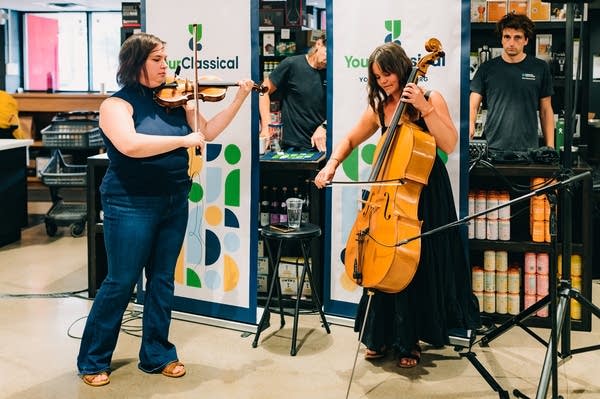sensual: (adjective) relating to or involving gratification of the senses
For many of us, nothing compares with classical music in the way it — choose a verb: pleases, delights, exhilarates — one of those senses, hearing. And for many of us, few practices elate two of our senses, smell and taste, the way wine does.
Which means that food is not the only experience that can be heightened by a splendid pairing with fermented grape juice. A well-chosen classical piece can stimulate our enjoyment of both the wine and the music and, as with food, can affect our perception of either in often-delightful ways.
And yes, that's even true with the offerings from Minnesota's nascent wine industry, which has made marked advances in recent years.
In pondering pairings, it's helpful to lean toward "like with like" matchups. For example, Carl Orff's often-thunderous Carmen Burana is much better suited for a deep, dark syrah than a bright, lithe pinot grigio. Conversely, Gustav Holst's shimmering "Venus, the Bringer of Peace" from The Planets would resonate mightily with that delicate white, but not the burly red.

Syrah, pinot grigio and most other familiar grapes cannot withstand Minnesota's harsh winter, but grape breeders have developed hybrids, melding European and Upper Midwest grapes, that survive and thrive here. The most widely available ones — including Marquette and Frontenac on the red side and La Crescent, and recent addition Itasca, for whites — emanated from the same University of Minnesota program that developed the Honey Crisp and Zestar apples.
Sometimes, what a wine evokes or how it was made (including blending and the use of oak) can be key factors in making something work rather than just the grape variety itself. At Morgan Creek Vineyards near New Ulm, Minn., the Marti family has found an ideal — and surprising — complement for its Puck's Pride blend, aged in whiskey barrels.
Winemaker's assistant Ben Marti cited the "bright cherry from the Frontenac and blackberry and plum from the Marquette, plus a nice hint of vanilla or dark chocolate from the oak" as components of the wine. "It's got kind of a flirty tango vibe going on," which led his all-musician family to the works of Argentine composer Astor Piazzolla. It doesn't hurt, Marti added, that the wine boasts "a sophistication, and the whiskey barrel has that kind of Buenos Aires grit."
A grape's parentage also can be a factor. Morgan Creek's Zeitgeist is made with La Crescent, whose parentage includes Muscat Hamburg. So it would pair well with Bach's Brandenburg Concertos, "partly just that German connection," Marti said. "It's got a lightness with the bright lemon and apple and pear, and a lively spring character."
As for Itasca, released in 2016 and just now getting suitable vine age, "a lot of people compare it to sauvignon blanc, with that slight grassy tone but bright, crisp, fresh flavors," Marti said. "This we thought would go really with [Claude] Debussy's The Girl with the Flaxen Hair. Some Debussy is dark, but this is a little more like floating in the wind, the flaxen hair floating in the wind."
That's the same kind of approach Sara Hicks, principal conductor of Live at Orchestra Hall with the Minnesota Orchestra, brings to the proceedings.
"When I hear sauvignon blanc, I always think spring," she said, citing Johann Strauss II's Voices of Spring Waltz and Ludwig van Beethoven's Violin Sonata No. 5, known as the Spring Sonata. Another direction: Igor Stravinsky's ballet Apollo, "because it's so linear and clean," she said.

As for the spicy nature of something like Marquette, Hicks gravitates to Manuel de Falla's The Three-Cornered Hat ballet and Maurice Ravel's Rapsodie Espagnole "for its pepperiness."
That kind of thinking is a key to unlocking and finding marriages made in musical heaven.
All of which points to a crucial element: Individual tastes in music and beverages vary — no two palates are identical — but many grape varieties have common characteristics that provide plenty of pairing opportunities.
Marquette, no matter how it is vinified, tends to be spicy. That's why the Latin and Spanish-lace compositions work so well, but so might Ravel's Bolero or Felix Mendelssohn's Symphony No. 4 (Italian). La Crescent absolutely reflects its Germanic heritage, so it's a good thing there are so many standout composers from that part of the world.
If it all sounds too complicated, there's an easy fallback: Play music you like with wine you like.
And here's the best news of all on the sensual front: Minnesota wines have improved enough that experimenting is more pleasurable than ever.
Contributing writer Bill Ward covers the wine world extensively for the Star Tribune and other media. Read more on his website, Decant This.

This activity is made possible in part by the Minnesota Legacy Amendment‘s Arts & Cultural Heritage Fund.
Love the music?
Show your support by making a gift to YourClassical.
Each day, we’re here for you with thoughtful streams that set the tone for your day – not to mention the stories and programs that inspire you to new discovery and help you explore the music you love.
YourClassical is available for free, because we are listener-supported public media. Take a moment to make your gift today.









